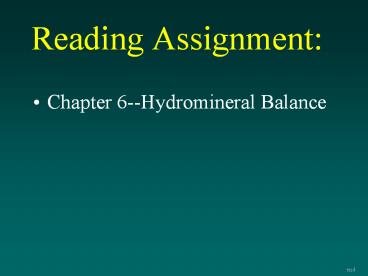Reading Assignment: - PowerPoint PPT Presentation
1 / 21
Title:
Reading Assignment:
Description:
guppy. end. Physiological Thermoregulation. few fishes--tunas & lamnid sharks ... rete mirabile for heat exchange & conserv. fish are large--low surface area ... – PowerPoint PPT presentation
Number of Views:41
Avg rating:3.0/5.0
Title: Reading Assignment:
1
Reading Assignment
- Chapter 6--Hydromineral Balance
end
2
Thermoregulation
- Cold-blooded -poor descriptor
- Poikilotherm (n) poikilothermic (adj)
- variable body temperature
- opposite homeotherm
- Ectotherm (n) ectothermic (adj)
- temp. determined by environment
- opposite endotherm
end
3
Why are fishes ectothermic?
end
4
Behavioral Thermoregulation
- nearly all fishes
- choose from available temperatures
- concept of temperature preference
end
5
Temperature Preference
Frequency
Temperature C
end
6
Temperature Preference continued
cold adapted
warm adapted
Frequency
Temperature C
end
7
Temperature Preference continued
The effect of Acclimation
Frequency
Temperature C
end
8
Temperature Preference continued
The effect of Acclimation
bluegill
temperature tolerance
Preferred Temperature C
Acclimation Temperature C
end
9
Temperature Preference continued
The effect of Acclimation
bluegill
???
guppy
Preferred Temperature C
chum salmon
Acclimation Temperature C
end
10
Physiological Thermoregulation
- few fishes--tunas lamnid sharks
- fish are active --generate heat
- rete mirabile for heat exchange conserv.
- fish are large--low surface area to mass ratio
- body surf. area increases as square of length
- body mass increases as cube of length
end
11
Physiological Thermoregulation
skin
gills
body
skin
end
12
Counter-current blood flow
from body
high
heat
venous blood
Temperature
arterial blood
from gills
low
Distance along capillaries (rete)
end
13
Counter Current flow
- fluid flowing in opposite directions
- exchange of heat or gas perpendicular to flow
- efficiency versus speed
end
14
Hypothetical Co-current blood flow
from body
high
counter-current
venous blood
Temperature
arterial blood
from gills
low
Distance along capillaries (rete)
end
15
Hypothetical Co-Current flow
- fluid flowing in same direction
- exchange of heat or gas perpendicular to flow
- speed versus efficiency
- vessels naturally flow in opposite direction
end
16
end
17
Hydromineral Balance Life in a solvent
- Environmental forces cause movement of water and
dissolved substances - versus
- Homeostasis--the need to maintain balance of
water and dissolved substances in cells and body
fluids of organisms - -constant internal environment
end
18
Environmental forces
- heat--(movement of molecules) energy for movement
- diffusion--net movement of molecules
- pressure--density of molecules
- difference causes or blocks movement
- osmosis--movement of water
- electrochemical forces--attraction repulsion of
molecules based on charge
end
19
- Environmental forces work together toward
equilibrium - equilibrium-no net movement of molecules
end
20
end
21
Lecture Exam Monday
- 100 point exam
- covers lectures, assigned readings
- 8-12 short answer questions 4-6 pts ea
- complete, concise answer
- ex definition
- 3-5 longer questions 10-15 pts ea
- Finish by 155--budget time
- Power Point lectures at
- http//www.und.nodak.edu/instruct/skelsch/4251.ht
m































